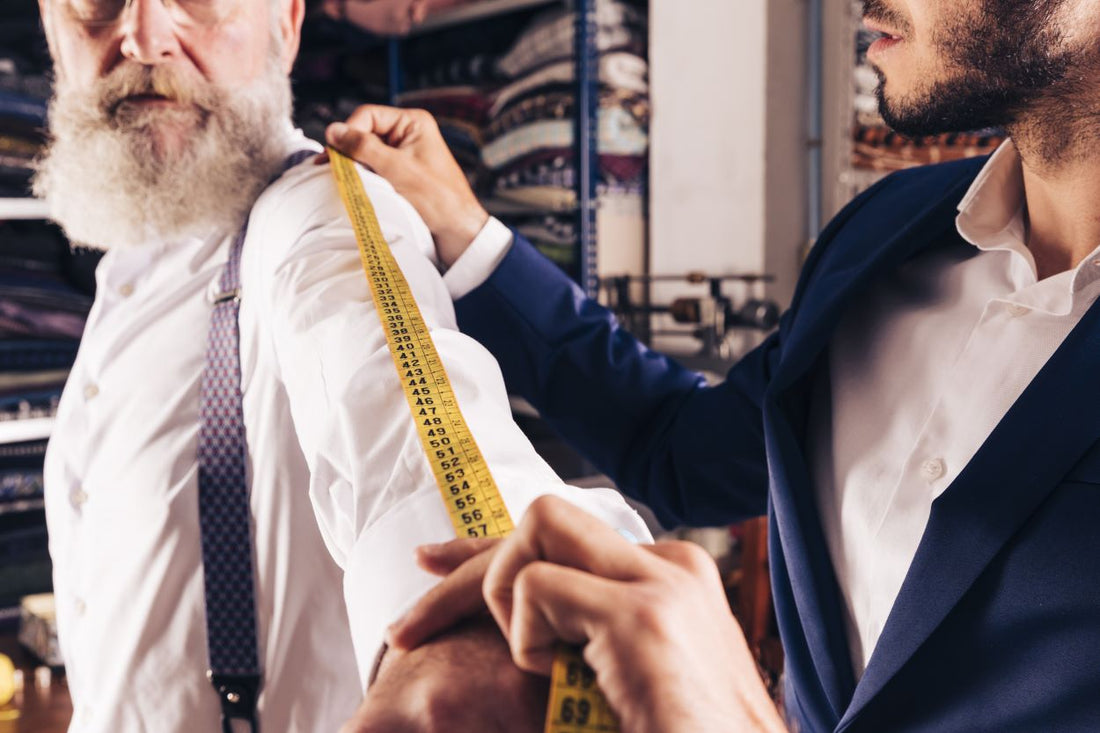
Finding the Perfect Fit: A Guide to Men's Suit Measurements
Share

Introduction
When it comes to dressing sharp, nothing beats the confidence of wearing a perfectly fitted suit. Whether you're preparing for a wedding, a job interview, or just want to elevate your wardrobe, getting the right fit is crucial. Accurate suit measurements ensure that your suit not only looks great but also feels comfortable.
This guide will walk you through everything you need to know about men's suit measurements, helping you achieve that flawless fit every time.
Why Accurate Suit Measurements Matter
The difference between a good suit and a great suit often comes down to how well it fits. A well-fitted suit enhances your appearance, boosting both your style and confidence.
Proper suit measurements are essential because they ensure that every part of the suit—from the shoulders to the trousers—fits just right, making you look polished and professional. Without accurate measurements, even the most expensive suit can look sloppy or uncomfortable.
Essential Tools for Suit Measurements
Before you begin measuring, you'll need a few essential tools:
-
Measuring Tape:A flexible measuring tape is crucial for accurate measurements.
-
Notepad and Pen:Jot down your measurements as you go.
-
Full-Length Mirror:A mirror helps ensure you're measuring correctly, especially for hard-to-reach areas.
-
Assistance:If possible, have someone help you, as some measurements are tricky to take alone.
These tools will help you capture precise measurements, setting the foundation for a suit that fits like a glove.
How to Measure for a Suit
Taking your measurements accurately is the key to finding the perfect suit. Follow these step-by-step instructions to measure yourself correctly.
Measuring the Chest
- Stand upright with your arms at your sides.
- Wrap the measuring tape around the fullest part of your chest, usually across the nipples.
- Ensure the tape is snug but not tight, and record the measurement.
Measuring the Shoulders
- Measure from the edge of one shoulder across to the edge of the other shoulder.
- The tape should follow the natural curve of your back.
Measuring the Waist
- Measure around your natural waistline, which is typically just above the belly button.
- Keep the tape snug but comfortable.
Measuring the Hips
- Measure around the fullest part of your hips, ensuring the tape stays parallel to the floor.
Measuring the Sleeve Length
- Start from the shoulder seam down to the wrist bone.
- Bend your arm slightly while measuring to get an accurate sleeve length.
Measuring the Jacket Length
- Measure from the base of your neck down to where you want the jacket to end, usually around the mid-thigh.
Measuring the Trouser Waist and Length
- Measure around your waist where you normally wear your trousers.
- For the length, measure from the waist down to the desired trouser length.
Measuring the Inseam
- Measure from the crotch down to the bottom of the leg.
These measurements will help you find a suit that fits well and looks great.
Understanding Suit Size Charts
Once you have your measurements, the next step is to interpret them using a suit size chart. Suit size charts convert your measurements into standard suit sizes, which can vary slightly between brands.
- Chest Measurement: Usually corresponds to the suit jacket size.
-
Waist Measurement: Used for selecting the correct trouser size.
Match your measurements to the closest size on the chart, keeping in mind that some adjustments may be necessary.
Common Mistakes to Avoid When Measuring for a Suit
Avoid these common pitfalls to ensure your measurements are as accurate as possible:
- Tight Measuring: Avoid pulling the tape too tight, as this can lead to an uncomfortable fit.
- Incorrect Posture: Stand naturally when measuring; don’t puff out your chest or suck in your stomach.
-
Overlooking Assistance: Having someone help you can lead to more accurate measurements, especially for the back and shoulders.
Being mindful of these errors will help you avoid a poorly fitted suit.
Perfect Suit Fit: Tailoring Tips
Even with the best measurements, a suit might still need some tweaks. Here are some tailoring tips to achieve the perfect fit:
- Jacket Alterations: The shoulders should fit perfectly; everything else can be tailored.
- Trouser Adjustments: Adjust the length and waist for comfort and style.
- Sleeve Length: Ensure your sleeves show about half an inch of shirt cuff.
These small adjustments can make a big difference in how your suit fits and feels.
FAQs on Men's Suit Measurements
How should a suit fit a man?
A suit should be snug but not tight, with the jacket lying flat against the shoulders and the trousers fitting comfortably around the waist and hips.
What are the measurements for a suit?
Key measurements include chest, waist, hips, shoulder width, sleeve length, jacket length, and inseam.
How do I measure myself for a suit at home?
Follow the step-by-step guide above, or consider getting help from a friend to ensure accuracy.
What size suit should I get for my height and weight?
Use a suit size chart and match your measurements to the closest size.
How do you measure chest size for a suit?
Wrap the tape around the fullest part of your chest, keeping it level and snug.
Conclusion
Accurate suit measurements are the foundation of a well-fitted suit. By following this guide, you'll be well on your way to finding a suit that looks and feels perfect. For those looking for an even more precise fit, consider to buy custom suit options or consulting with a professional tailor.
Whether you're shopping for your next business suit or preparing for a special occasion, the right custom suit measurements guide will ensure you look your best.

